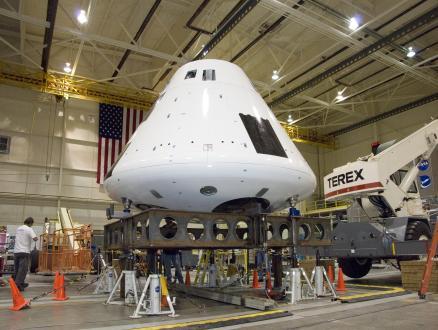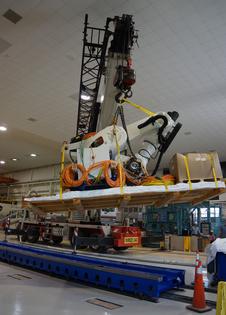NASA Installs Giant Composite Research Robot
December 15, 2014

NASA has just installed a giant robot to help in its research on composite aerospace materials. The robot, named ISAAC (Integrated Structural Assembly of Advanced Composites), is a massive mechanized arm that slides up and down a 40-ft track in preprogrammed patterns while laying down an epoxy matrix and carbon fibers with exact precision. NASA is investigating the use of composites for aviation, spacecraft, and launch systems.
Of course, composites are already used in spacecraft, such as the Juno satellite headed toward Jupiter, the MAVEN spacecraft headed toward Mars, and the Orion space capsule launched December 5. TenCate, well-known for its aerospace composites, built heat-resistant composites that replaced titanium in Orion's 16.5-ft diameter heat shield and the crew vehicle backshell structure. The company says the development and qualification process took five years.
Click on the photo below to start the slideshow.

NASA's interest in using ISAAC for R&D is to advance composite research and certification in order to reduce the time for development, verification, and regulatory acceptance of new materials and structures. That's the drive behind its Advanced Composites Project (ACP), part of the Aeronautics Research Mission Directorate's Integrated Systems Research Program, a partnership between government and industry launched in 2013.
According to a NASA press release, it currently takes approximately 20 years to get composites through the design, testing, and manufacturing stages. "The goal of our program really is to focus on how quickly we can turn out products using existing materials with reduction in this timeline for development by at least 30%," said ACP project manager Rick Young. To help speed up the process, the ACP is concentrating on predictive capability, rapid inspection, and enhanced manufacturing.
ISAAC will be used to develop advanced materials, as well as related processes such as high-fidelity and rigorous computational methods, new test protocols, structural concepts, and manufacturing and inspection techniques. NASA says the giant robot arm is one of only three such systems in the world, all made by Electroimpact. The other two systems are used for manufacturing composites in bulk.
ISAAC is being housed in the Advanced Manufacturing and Flight Test Articles Development Laboratory at the agency's Langley Research Center in Hampton, VA. After delivery, the 21-ft-long robotic arm had to be moved by a huge crane into place on its track.
Electroimpact's technicians will continue to work for several weeks putting ISAAC through its paces. Langley's researchers plan to have ISAAC up and running by early 2015.
ISAAC will also be available for research related to specific space projects. The first will be the Composites for Exploration Upper Stage (C-EUS) project. This partnership between NASA's Space Technology Mission Directorate and Human Exploration Mission Directorate led by the Marshall Space Flight Center will last three years. It will focus on designing, building, testing, and addressing flight certification of a large composite shell for the second stage of the Space Launch System. Langley will lead the design, manufacture, and testing of the shell's structural joints, as well as overall structural and thermal analyses.
Related posts:
About the Author(s)
You May Also Like



